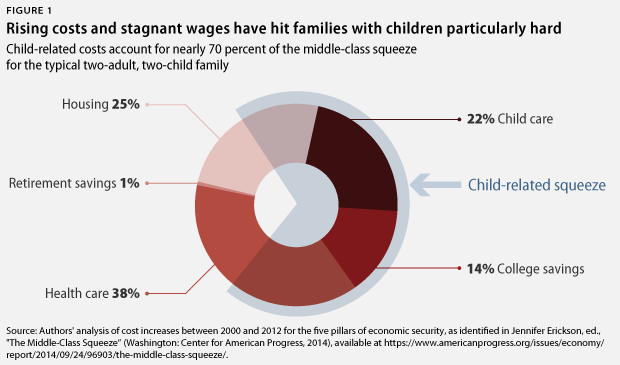See also: Harnessing the Child Tax Credit as a Tool to Invest in the Next Generation by Rachel West, Melissa Boteach, Rebecca Vallas
Costs associated with key pillars of middle-class economic security have risen dramatically in recent years, while incomes have stagnated. This has pushed many American families to the financial brink. The middle-class squeeze has hit families with children especially hard: Child-related costs account for nearly 70 percent of these rising costs and have increased at a much faster rate than other costs.

The problem is particularly acute for families with young children, who, at this age, are in the most critical years for brain development. In 2013, nearly 23 percent of infants and toddlers lived in households with incomes below the federal poverty line. In fact, the birth of a child is one of the leading triggers of a poverty spell in the United States.
Childhood economic insecurity is harmful and costly
Economic insecurity is enormously detrimental to children’s long-term health, education, and employment outcomes. What’s more, child poverty is detrimental to society as a whole, costing the U.S. economy $672 billion per year. Yet, the United States spends just 1.2 percent of gross domestic product, or GDP, on family benefits, less than half of the 2.6 percent average in other developed nations.
Limitations of the current Child Tax Credit
The Child Tax Credit, or CTC, which provides families with a tax credit of up to $1,000 per child younger than age 17, is an important policy tool to boost family economic security and invest in our nation’s children. However, the CTC has several limitations:
- The credit is not fully refundable, preventing it from reaching the lowest-income children, and its minimum earnings requirement excludes many families who experience job loss.
- The credit is not tied to inflation, so its value erodes each year that Congress does not act. As a result, the CTC has lost more than one-third of its value since 2000.
- Families must wait until tax time to claim the CTC, despite the fact that expenses such as diapers, infant hygiene products, and cribs cannot wait until tax time.
- The CTC’s modest benefit does not increase when families’ needs are greatest—when children are young and parental earnings are relatively low.
Recommended enhancements
In recognition of these limitations, the Center for American Progress’ proposal would strengthen the CTC as a tool to invest in the next generation by:
- Eliminating the minimum earnings requirement and making the credit fully refundable to ensure that it reaches all low- and moderate-income families with children
- Indexing the value of the credit to inflation so that it does not continue to lose value over time, even as the costs of reaching or staying in the middle class rise
- Supplementing the CTC with a Young Child Tax Credit of $125 per month for children younger than age 3, available monthly through direct deposit or the Direct Express card
CAP’s proposed enhancements would substantially boost the CTC’s power as an anti-poverty and economic mobility tool, with especially strong effects for young children and children of color. These enhancements would protect nearly twice as many children younger than age 17 from poverty—and two-and-a-half times more children younger than age 3—compared with current law. The enhancements would also significantly lessen the depth and severity of poverty, closing more than one-quarter of the poverty gap for children younger than age 3 who remain poor.
Rachel West is an Associate Director for the Poverty to Prosperity Program at the Center for American Progress. Melissa Boteach is the Vice President of the Poverty to Prosperity Program at the Center for American Progress. Rebecca Vallas is the Managing Director for the Poverty to Prosperity Program at the Center.